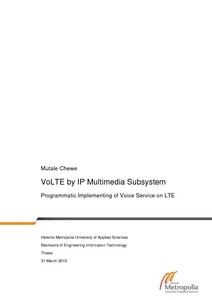VoLTE by IP Multimedia Subsystem : Programmatic Implemeting of Voice Service on LTE
Chewe, Mutale (2015)
Chewe, Mutale
Metropolia Ammattikorkeakoulu
2015
All rights reserved
Julkaisun pysyvä osoite on
https://urn.fi/URN:NBN:fi:amk-201505219338
https://urn.fi/URN:NBN:fi:amk-201505219338
Tiivistelmä
A test-driven approach for rapidly deploying Voice over LTE (VoLTE) would prove essential, considering the revenues being lost to Internet protocol (IP) based solutions such as Voice over IP (VoIP). Subsequently voice development for LTE networks is indispensable considering that VoIP has no Quality of Service (QoS) guarantee, which consequently renders it unreliable. The thesis project aimed at analysing and describing the implementation of VoLTE from a programmatic perspective, focusing on end-to-end validation of a basic VoLTE configuration by using industrial test tools to validate functional and logical entities requisite in achieving a cumulative delay of less than 200 ms, widely held and shown to be the minimum acceptable latency for a practically deployable VoLTE system.
The test scope primarily centred on signalling, transport methods and call handling functions. Validating deployment scenarios were executed using LTE capable network configuration test emulators that included an R&S CMW500 development test platform manufactured by Rohde & Schwarz and the Spirent E2010S.
The final analysis showed that scheduling methods, packet bundling and codecs can improve voice quality. Ultimately the basic VoLTE topology showed finer performance with increased bandwidth and data speeds in a wider frequency range for FDD implementation. Consequently VoLTE by IP Multimedia Subsystems (IMS)-enabled Multimedia telephony (MMtel) proved practical having met the mouth-to-ear delay of less than 200 ms.
The test scope primarily centred on signalling, transport methods and call handling functions. Validating deployment scenarios were executed using LTE capable network configuration test emulators that included an R&S CMW500 development test platform manufactured by Rohde & Schwarz and the Spirent E2010S.
The final analysis showed that scheduling methods, packet bundling and codecs can improve voice quality. Ultimately the basic VoLTE topology showed finer performance with increased bandwidth and data speeds in a wider frequency range for FDD implementation. Consequently VoLTE by IP Multimedia Subsystems (IMS)-enabled Multimedia telephony (MMtel) proved practical having met the mouth-to-ear delay of less than 200 ms.
